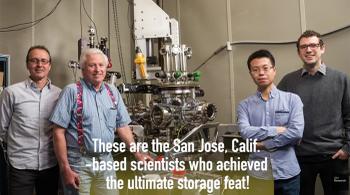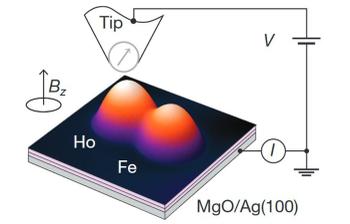On Wednesday researchers at IBM revealed that they have managed to store and retrieve data on a single atom. Previous research reportedly hit the limits of read/write functionality with addressable bistable magnetic bits consisting of 3-12 atoms. For comparison, current mechanical hard drives rely on approx 100,000 atoms for magnetic storage of a single data bit.
IBM's researchers used atoms of Holmium (Ho) on a bed of magnesium oxide. This atom has many unpaired electrons and in this state has a property known as magnetic bistability - two stable magnetic states with different spins exhibited. To write data to the single atom the IBM researchers applied about 150 millivolts at 10 microamps to it using a scanning tunneling microscope (an IBM invention). The magnetic state of the atom is subsequently read using tunnel magnetoresistance.
If you look at the diagram above, you will see that the Ho atom is next to an Iron (Fe) atom. That Fe atom was placed by the researchers to verify the Ho atom was in a different magnetic state as it is influenced by its magnetic neighbourhood. It verifies that the read/writes of the Ho atom are a lasting stored magnetic state but it is only there for experimental purposes.
The researchers also tested scaled-up Ho storage with two Ho atoms situated a nanometre apart. In tests they could reliably write and read back four possible states with each atom's magnetism being changed independently (00,01,10,11).
If IBM were to scale this Ho storage up to the size of a credit card it would be able to store the entire iTunes catalogue (all 35 million tracks) reports Engadget. Unfortunately that isn't likely, as the Ho atoms in the tests needed to be liquid Helium cooled and in a near perfect vacuum. IBM will continue to research with "atoms of other elements, clusters of atoms, and small molecules as candidate magnetic bits," one of the researchers told TechCrunch. As often is the case, this research shows much potential but certainly needs time to develop into something practical.








